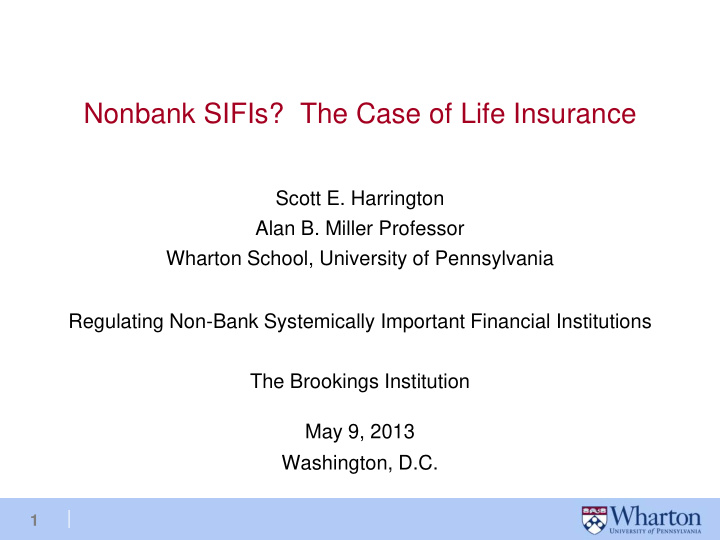



Nonbank SIFIs? The Case of Life Insurance Scott E. Harrington Alan B. Miller Professor Wharton School, University of Pennsylvania Regulating Non-Bank Systemically Important Financial Institutions The Brookings Institution May 9, 2013 Washington, D.C. 1
Economically efficient regulation (in practice) At its best, economic regulation involves enforcement and compliance costs, is inherently imperfect, and risks significant, unintended consequences Regulation should only be employed when: 1. Substantial evidence of significant market failure 2. Substantial reason to believe that the benefits will exceed the costs Regulatory tools should be carefully matched with specific market failures (See, for example, Stephen Breyer, Regulation and its Reform , Harvard University Press, 1982) 2
FSOC designation of nonbank SIFIs • Designation, subject to enhanced regulation by the Federal Reserve, . . . if the Council determines that material financial distress at the U.S. nonbank financial company, or the nature, scope, size, scale, concentration, interconnectedness, or mix of the activities of the U.S. nonbank financial company, could pose a threat to the financial stability of the United States . • Three stage, quantitative and qualitative evaluation • No bright line for designation • Prudent policy should consider the risks and unintended consequences of designation 3
AIG • AIG’s crisis was not caused by core insurance activities • Its CDS problems were unique • Its securities lending problems were unique • We don’t fully understand how an AIG failure would have affected its non-insurance counterparties, which were recipients of the bulk of the federal assistance • AIG was subject to consolidated supervision (by the Office of Thrift Supervision) • Large banks experienced severe problems despite extensive regulation by the Fed, including problems related to off balance sheet vehicles 4
Systemic risk • Threat to overall financial system with spillovers on real activity Large, macroeconomic shocks Interconnectedness among institutions and associated contagion • Possible sources of contagion: Fire sales depress asset prices and holdings of institutions with similar assets Counterparty risk – some firms may be unable to honor their commitments, causing some counterparties to likewise default, etc. Uncertainty/opacity of financial problems at some institutions creates general uncertainty, making parties reluctant to trade until further information is available Irrational contagion – investors and/or customers withdraw funds without regard to whether specific institutions at risk 5
Is life insurance systemically risky? • Assessments generally conclude that core activities pose little or no systemic risk • Compared with banks, financial distress of life insurers does not threaten the payment system or short-term lending • Banking crises have much greater potential to produce rapid and widespread harm to economic activity • Life insurers: Longer-term, less liquid liabilities; substantial time to resolve financial distress; extensive duration/maturity matching; separate accounts; substantial market discipline • Lessons from the early 1990s and 2008-2010 Flight to quality; withdrawals focused on problem institutions Life insurers as victims rather than perpetrators 6
Quantitative systemic risk measures • Based in part on correlation in stock returns in down markets (MES, highly correlated with equity beta) • Some measures rank a few life co. highly (e.g., SRISK) • Elegant conceptual and empirical frameworks; quantitative sophistication is estimating correlations in down markets • Seemingly precise, but not necessarily very accurate SRISK very highly correlated with total liabilities (Benoit, et al., 2013) Different risk measures yield significantly different rankings Do not measure causation Little attention/linkage to underlying drivers of potential contagion Assumptions not tailored to specific sectors (SRISK: common “prudent” capital ratio; book liabilities; no consideration of nature or duration of liabilities; no distinction of separate account liabilities) 7
Potential consequences of life insurer SIFI designation For life insurers, consumers, and markets 1. At least in the short run, significant risk of excessive regulatory burdens and costs for companies designated as systemically important, disrupting competition and harming customers, especially if bank centric regulation is imposed 2. In the long run, risk of increased moral hazard, less market discipline, and expansion of “too big to fail” For regulation / supervision 1. Fixed costs and lags in developing appropriate expertise and rules for very few entities 2. Potential diseconomies of scope in Federal Reserve supervision of banks and nonbank SIFIs 3. Possible changes in political dynamic regarding stricter capital requirements and supervision of large entities 8
Market discipline and too big to fail • A lack of market discipline in subprime mortgage lending and investment was a major cause of the financial crisis • A key goal of regulatory responses should be to avoid further expansion of too big to fail policy and undermining market discipline in other sectors • Insurance markets are characterized by relatively strong market discipline and low insolvency risk Limited, state-based guarantees of insurers’ obligations Risk-sensitive policyholders, intermediaries, and creditors Insurance production and distribution often involve creation of franchise value that could be lost from financial distress, increasing incentives for risk management • A potential weakening of market discipline should be weighed carefully when deciding whether to single out a few entities for special treatment 9
Conclusion • No compelling evidence that any life insurer poses a threat to the financial stability of the United States • If one or more life insurers did pose a threat to financial stability, there is considerable uncertainty concerning the best approach to regulation and the effectiveness of such regulation • Designation of one or more life insurers as systemically important and subject to enhanced supervision by the Federal Reserve would risk significant, unintended consequences • These considerations militate against designating any life insurers as SIFIs 10
Recommend
More recommend